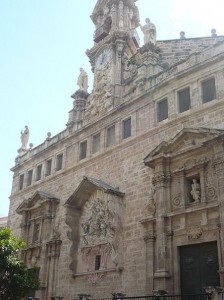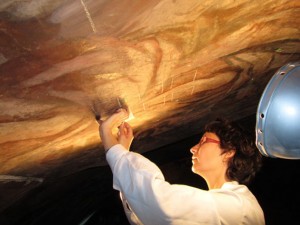 A multidisciplinary team of art experts and microbiologists from the Polytechnic University of Valencia are using bacteria to clean 17th century frescoes by Antonio Palomino in the Church of Santos Juanes of Valencia. The technique was developed by Italian microbiologist Giancarlo Ranalli and first used to clean frescoes from the Camposanto Monumentale, a 13th century cloister next to the Leaning Tower of Pisa. Premier Italian restorers Gianluigi Colalucci, Donatella Zari and Carlo Giantomassi, who worked on the Camposanto frescoes, are in Valencia sharing their expertise with the Spanish team.
A multidisciplinary team of art experts and microbiologists from the Polytechnic University of Valencia are using bacteria to clean 17th century frescoes by Antonio Palomino in the Church of Santos Juanes of Valencia. The technique was developed by Italian microbiologist Giancarlo Ranalli and first used to clean frescoes from the Camposanto Monumentale, a 13th century cloister next to the Leaning Tower of Pisa. Premier Italian restorers Gianluigi Colalucci, Donatella Zari and Carlo Giantomassi, who worked on the Camposanto frescoes, are in Valencia sharing their expertise with the Spanish team.
The murals were damaged by a fire in 1936, then damaged again by the faulty restoration in the 1960s. The restorers back then used animal glue to replace detached frescoes. Over time the glue hardened leaving an insoluble layer. Restorers from the Institute of Heritage Restoration began the restoration trying to use a digital printing technique to fill in cracks in the paint only to find themselves thwarted by salt efflorescence, white incrustations caused by the buildup of crystallized salts after the fire, and the glue residue. Conventional methods to fix these problems either require the use of toxic chemicals, which are non-selective and can end up harming elements other than the salts and glue, or mechanical scraping that is time-consuming and can damage the paint further.
 Hoping to find a solution, microbiology professor Rosa Maria Montes Estellés and Pilar Bosch, a biologist with a Ph.D. in Science and Heritage Restoration, went to Italy to learn about the new bacteria technology from Colalucci and his colleagues who were just finishing up on the Camposanto frescoes. The Italian team used cotton to apply strains of bacteria specifically selected to address the Camposanto issues.
Hoping to find a solution, microbiology professor Rosa Maria Montes Estellés and Pilar Bosch, a biologist with a Ph.D. in Science and Heritage Restoration, went to Italy to learn about the new bacteria technology from Colalucci and his colleagues who were just finishing up on the Camposanto frescoes. The Italian team used cotton to apply strains of bacteria specifically selected to address the Camposanto issues.
In nature there are bacteria that feed on pretty much anything, so the first step is picking your bacterium and encouraging it to focus on whatever substances you need removed. Polytechnic University of Valencia biologists then trained their bacteria, a strain of Pseudomonas, to devour the salt efflorescence and glue residue. They developed a gel delivery system which is more effective than the cotton balls because it can be applied more quickly and more evenly and it coats the entire surface, preventing moisture from penetrating into the paint. The gel remains on the fresco for just an hour and a half, then the restorers remove it. Once the surface is cleaned and dried, any remaining bacteria die off.
The bacteria are not dangerous to humans and since they only feed on specific elements, they don’t bother anything else. They eat the salts and the glue then stop, never touching the paint itself. It’s kind of like surgical maggots used in hospitals to clean necrotic tissue: they remove the dead cells at a microscopic level but never touch living tissue.
Thus far the Valencia team has tested the Pseudomonas gel on two lunettes of the church. They’ll do another two next. The entire restoration is expected to take three years. Scientists will continue to experiment with different species of bacteria, different surfaces and different damaging elements.